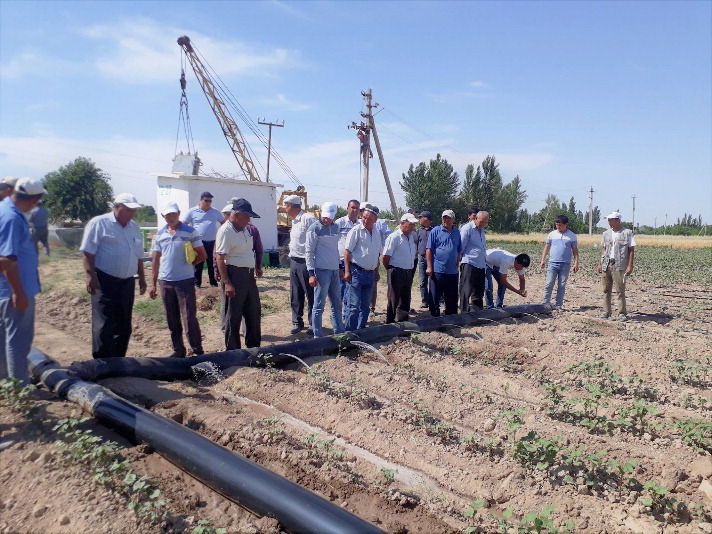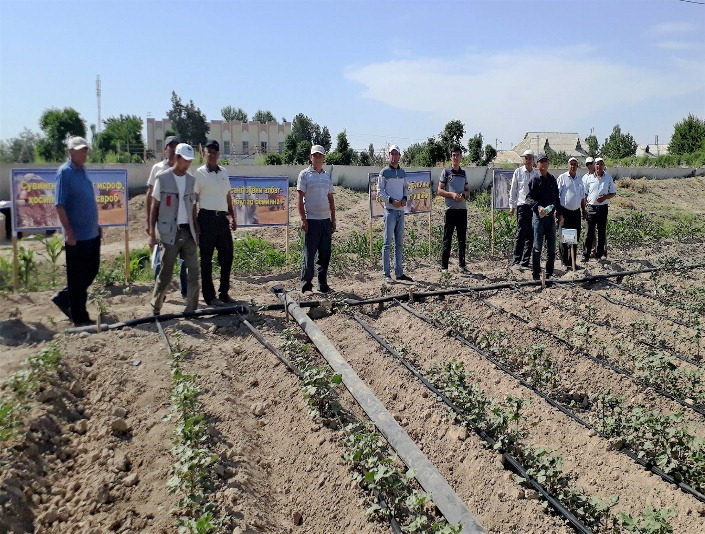|
Cycle 4 (2015 Deadline)
Mitigating the competition for water in Amudarya River basin, Central Asia, by improving water use efficiency PI: Kakhramon Djumaboev, International Water Management Institute, Central Asia Sub-Regional Office
U.S. Partner: James Ayars, USDA-ARS Water Management Unit
Project Dates: November 2015 - October 2018
USAID Story on Project - March 2021
Project Overview
The growing population of Central Asia has resulted in an increased demand for water for food and hydropower generation. Most of the renewable water resources are transboundary, with the main rivers flowing through several states. The hydropower generation potential is upstream, where the key reservoirs regulate the river flow, while the irrigated land, requiring 80% of the river flow, is located downstream. With water in short supply the competition for water between hydropower upstream and agriculture downstream results in reduced water use efficiency and, overall, in reduced basin-wide water productivity. Prior to recent changes, the operational regime of the upstream reservoir gave priority to upstream hydropower needs in the Syrdarya River basin, while the downstream states faced significant losses for irrigation. Developing the upstream hydropower potential may cause further reduction of water availability downstream during the crop-growing season. Under the current operating practices of the upstream reservoir, which prioritizes the needs of agriculture in the Amudarya River basin, the upstream states face significant energy shortages. The issue is very politically sensitive, when a win for one side means a loss for the other. Under these conditions securing water for agriculture through increased water use efficiency is critical for Central Asian states (Karimov et. Al, 2012).
The solution for the problem is highly complicated because of significant shortage of water to supply the needs of both – water for food and water for energy in Aral Sea basin. This project applied a two-step approach. The first was determining water and energy “gains” through increasing current water use efficiency and reducing current energy use intensity in different sectors (such as agriculture, domestic water and energy supply, industry, and power generation), which can be considered while supplying the water and energy needs of upstream and downstream users. The second was considering the above-indicated gains of demand management while analyzing benefits of cooperation. Close cooperation was established between the International Water Management Institute (IWMI) Central Asia, the United States Department of Agriculture – Agricultural Research Service (USDA-ARS), and local partners, including specialists from the Research and Design Institute UzGIP under the Ministry of Agriculture and Water Management, Uzbekistan.
 |  | | The project team provides water management best practices to farmers and stakeholders in the Kashkadarya region of Uzbekistan. |
Final Summary of Project Activities
One of the main objectives of this research project was to identify management practices and strategies to improve water and energy use in the Amudarya and Syrdarya river basins of Central Asia. Specifically, the project focused on assessment of water-use efficiency and energy-use intensity of different irrigation schemes at two sites in Uzbekistan and Tajikistan. Specific achievements of the project to date are (1) a geodatabase for the two study areas containing over 40 thematic maps; (2) demonstration of water-saving technologies and assessment of irrigation efficiency for furrow, gated pipe, and drip irrigation schemes in the study area; and, (3) evaluation of water-saving technologies and methods documenting the costs and benefits to the government, farmers, and society.
The overarching objective of project activities was to support informed and evidence-based decision making by sharing the results, data, and evidence from the PEER project with policymakers, water users, and civil society. During the last year of the project, the team did their best to translate the project outputs into meaningful and sustainable development impacts. A supplemental grant they received helped fund activities to translate project data, results, and evidence into user-friendly policy documents and multimedia materials, which can be easily accessed by policymakers and other relevant stakeholders, which should then enable them to develop informed and evidence-based policies and practices.
The team made a strong effort to share project results, data and evidence with the community and policymakers through multimedia materials. This involved a range of communication channels selected depending on the data and/or audience. The geodatabases for Zafarabad and Karshi Steppe, for example, were disseminated in hard copies and USB storage devices and shared with the local, national, and regional water authorities, water users’ associations, and donor organizations. This has enabled easy access to the geodatabase information on site characteristics, enabling remote users with no Internet connection to access the information. Increasing the user base for the geodatabase will help ensure it is tested and assessed by more people, enabling useful feedback on information contained in the database. To increase knowledge about the general project information and findings on water saving technology options, new printed materials including brochures and factsheets in local languages Russian and English were developed. Additional material haves been made available in digital form on the IWMI-CA webpage and social media platforms on Facebook. The data and information sharing was supported with direct contact with relevant stakeholders (office and field visits), participation in external events (e.g. national and regional symposiums, conferences, roundtable discussions), and through organizing targeted workshops that brought together water practitioners, researchers, decision makers and the donor community.
The project team organized three workshops to disseminate information to policymakers and to draft policy recommendations on the use of water-saving technologies based on evidence acquired through work on the PEER project. The PI and project team disseminated PEER project research findings by engaging farmers and policymakers. Two workshops were convened in Uzbekistan to discuss project results: a hands-on workshop near the Karshi steppe site for mid-level decision makers and farmers, including field visits and discussion of good practices, and a second workshop in Tashkent for high-level policy makers to disseminate research results on effective water- and energy-saving methods in agricultural production, as well as on the benefits of using decision-support tools such as GIS and RS/EO mapping tools and data in policymaking. The third workshop and associated training course were organized in Khujand, Tajikistan. The workshops involved relevant members of the governments of Uzbekistan and Tajikistan, as well as other regional stakeholders in the efforts to develop a regional water management strategy and policy framework on water use. Special focus was given to innovative methods and strategies in water policy and governance to engage stakeholders in solving complex problems in the Amudarya and Syrdarya river basins. In all of the workshops, the organizers presented community findings and proposed specific recommendations to improve management practices and policies.
The project team has also coordinated with local universities, research organizations, and other parts of civil society to achieve a stronger policy impact. The PI and the project team made concerted efforts to engage with local universities, research organization, and other parts of civil society to continuously share project findings and promote their use as evidence bases in other research projects (e.g., student theses, research papers, peer-reviewed publications, etc.) to increase the visibility of project results, data, and evidence and promote their application in practice and policymaking.
On July 17, 2023, PEER staff received the sad news that Dr. Djumaboev had passed away. Colleagues noted his wonderful, kind-hearted nature and willingness to lend a helping hand in all situations. PEER offers its deepest condolences to his family and friends.
IWMI Facebook Page
Back to PEER Cycle 4 Grant Recipients
|





